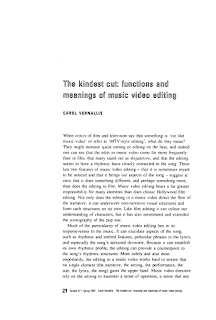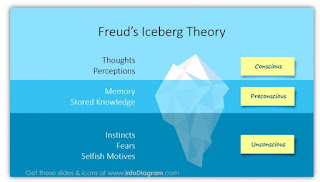Carol Vernallis and 'Experiencing Music Video' (2004)
Carol Vernallis is another influential film theorist who studied the relevance of four particular concepts within the production of most mainstream music videos. His theories all relate to the specifics of how a music video is produced.
Narrative
Within her work, Vernallis particularly focuses on the influence of narrative within music video production. In 'Experiencing Music Video: Aesthetics and Cultural Context' (2004), she suggests that the music video itself is a visual response to the lyrical content of the song itself. She also states within her explanation of this theory that "the narrative may not always be completed and can be partial with the video, appearing disjointed, disconnected and fragmented" (Kane Sewell, 2015), this occurs due to lacadaisical applications of typical narrative film theory to much shorter promotional musicl video, which could either act to present a continuing story line or motifs throughout the artist's subsequent work, or simply to confuse the audience if the stylistic approach is lacking.
"Music videos avoid Aristolian narratives and fully drawn stories for several reasons: (1) the genre's multimedia nature, (2) the lack of appropriateness and applicability of narrative film devices, and (3) the necessity of foregrounding the song's form (in order to sell the song)" (Carol Vernallis, 2004)
Editing
Vernallis also mentions editing as a fundamental focus of her study; she states particularly that music videos often break the fundamental rules of continuity, taking the audience away from typical film conventions found in narrative film or TV.
One commonly used editing technique within relation to music video editing is jump-cut transitions, which is when the footage cuts suddenly from one shot to another, and is a feature that originates from the French New Wave. Jump cutting 'breaks the rules' of continuity editing and often signifies the passage of time, which makes it an incredibly useful tool in short films such as music videos; in a music video, the cutting will often occur to the beat of the track, which makes it both appeasing to the viewer and relates the footage to the narrative in a semiotic manner.
Camera Movements/ Framing:
In Vernallis's theory, she suggests that establishing shots are a common element within mainstream music videos, particularly with the use of close-up and extreme close-up shots of the artists, which is relative to Andrew Goodwin's theory in 'Dancing in the Distraction Factory' and actually expands on these theories. These establishing shots are used to create a distinct recognition between the music and the artist who created it. Furthermore, "The style of framing of the video again is quite distinctive to the video and also the camera may move in time with the lyrics." (Kane Sewell, 2015). This is also a feature which establishes the artist or band to the viewer, creating recognition between the actions of the individual on screen and the lyrical or musical content of the track, making the stylistic approach to camera movement and framing within music videos dependant and varying to the genre of the track.
Digesis:
In context with film-making, "diegesis denotes the story of the movie. The diegesis refers to the fictional time, place, characters and events that make up the universe portrayed." (Maeve Maddox, 2015), this is also referred to as mise-en-scene, which again relates to theories first brought to light as an important feature of film-making of the French New Wave- essentially it is the world displayed to the audience in the video. Vernallis reports that in most cases, the diegesis in music videos is revealed slowly, which allows time for the development of the narrative. "She also states that repetition of certain shots and frames will be shown in a music video so they appear more important than others" (Elise Williamson, 2016) which often occurs due to the way that frames are shot. Finally, Carol Vernallis states that disruption of diegesis can occur in a music video; usually this disruption is as a cause of the narrative not being completed, which gives reasoning to the repetition of shots, as they act to assist the viewers interpretation of the video.
a \z
Bibliography:
Narrative
Within her work, Vernallis particularly focuses on the influence of narrative within music video production. In 'Experiencing Music Video: Aesthetics and Cultural Context' (2004), she suggests that the music video itself is a visual response to the lyrical content of the song itself. She also states within her explanation of this theory that "the narrative may not always be completed and can be partial with the video, appearing disjointed, disconnected and fragmented" (Kane Sewell, 2015), this occurs due to lacadaisical applications of typical narrative film theory to much shorter promotional musicl video, which could either act to present a continuing story line or motifs throughout the artist's subsequent work, or simply to confuse the audience if the stylistic approach is lacking.
"Music videos avoid Aristolian narratives and fully drawn stories for several reasons: (1) the genre's multimedia nature, (2) the lack of appropriateness and applicability of narrative film devices, and (3) the necessity of foregrounding the song's form (in order to sell the song)" (Carol Vernallis, 2004)
Editing
Vernallis also mentions editing as a fundamental focus of her study; she states particularly that music videos often break the fundamental rules of continuity, taking the audience away from typical film conventions found in narrative film or TV.
One commonly used editing technique within relation to music video editing is jump-cut transitions, which is when the footage cuts suddenly from one shot to another, and is a feature that originates from the French New Wave. Jump cutting 'breaks the rules' of continuity editing and often signifies the passage of time, which makes it an incredibly useful tool in short films such as music videos; in a music video, the cutting will often occur to the beat of the track, which makes it both appeasing to the viewer and relates the footage to the narrative in a semiotic manner.
Camera Movements/ Framing:
In Vernallis's theory, she suggests that establishing shots are a common element within mainstream music videos, particularly with the use of close-up and extreme close-up shots of the artists, which is relative to Andrew Goodwin's theory in 'Dancing in the Distraction Factory' and actually expands on these theories. These establishing shots are used to create a distinct recognition between the music and the artist who created it. Furthermore, "The style of framing of the video again is quite distinctive to the video and also the camera may move in time with the lyrics." (Kane Sewell, 2015). This is also a feature which establishes the artist or band to the viewer, creating recognition between the actions of the individual on screen and the lyrical or musical content of the track, making the stylistic approach to camera movement and framing within music videos dependant and varying to the genre of the track.
Digesis:
In context with film-making, "diegesis denotes the story of the movie. The diegesis refers to the fictional time, place, characters and events that make up the universe portrayed." (Maeve Maddox, 2015), this is also referred to as mise-en-scene, which again relates to theories first brought to light as an important feature of film-making of the French New Wave- essentially it is the world displayed to the audience in the video. Vernallis reports that in most cases, the diegesis in music videos is revealed slowly, which allows time for the development of the narrative. "She also states that repetition of certain shots and frames will be shown in a music video so they appear more important than others" (Elise Williamson, 2016) which often occurs due to the way that frames are shot. Finally, Carol Vernallis states that disruption of diegesis can occur in a music video; usually this disruption is as a cause of the narrative not being completed, which gives reasoning to the repetition of shots, as they act to assist the viewers interpretation of the video.
a \z
Bibliography:
- Maddox, M., (2015), 'Diegesis and Diegetic', published by 'Daily Writing Tips', available from:https://www.youtube.com/watch?v=s8GvLKTsTuI
- Sewell, K., (2015), 'Carol Vernallis' Theory',published on 'Prezi.com', available from: https://prezi.com/qm52-awpar4p/carol-vernallis-theory/
- Vernallis, C., (2004), 'Experiencing Music Video',



Comments
Post a Comment